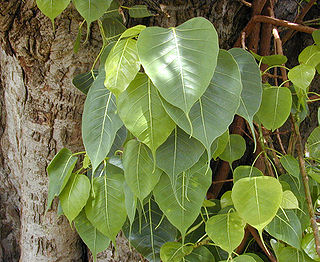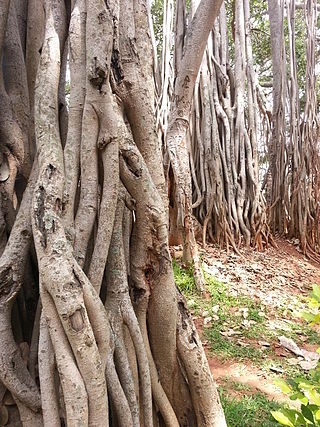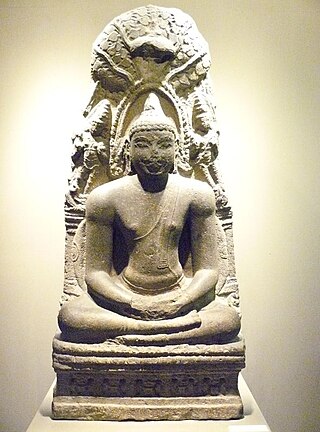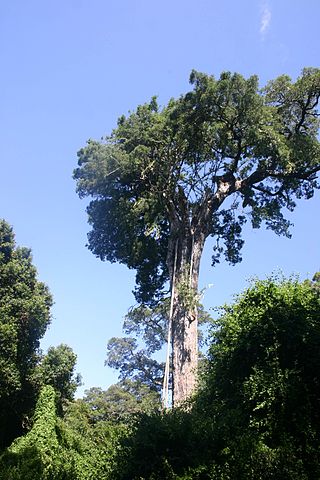Animism is the belief that objects, places, and creatures all possess a distinct spiritual essence. Animism perceives all things—animals, plants, rocks, rivers, weather systems, human handiwork, and in some cases words—as being animated, having agency and free will. Animism is used in anthropology of religion as a term for the belief system of many Indigenous peoples in contrast to the relatively more recent development of organized religions. Animism is a metaphysical belief which focuses on the supernatural universe : specifically, on the concept of the immaterial soul.

Ficus is a genus of about 850 species of woody trees, shrubs, vines, epiphytes and hemiepiphytes in the family Moraceae. Collectively known as fig trees or figs, they are native throughout the tropics with a few species extending into the semi-warm temperate zone. The common fig (F. carica) is a temperate species native to southwest Asia and the Mediterranean region, which has been widely cultivated from ancient times for its fruit, also referred to as figs. The fruit of most other species are also edible though they are usually of only local economic importance or eaten as bushfood. However, they are extremely important food resources for wildlife. Figs are also of considerable cultural importance throughout the tropics, both as objects of worship and for their many practical uses.

Ficus benghalensis, or Ficus indica commonly known as the banyan, banyan fig and Indian banyan, is a tree native to the Indian Subcontinent. Specimens in India are among the largest trees in the world by canopy coverage. It is also known as the "strangler fig" because it starts out as epiphyte, that is, leaning on another tree that it ends up suffocating.

Ficus macrophylla, commonly known as the Moreton Bay fig or Australian banyan, is a large evergreen banyan tree of the Mulberry Family (Moraceae) native to eastern Australia, from the Wide Bay–Burnett region in the north to the Illawarra in New South Wales, as well as Lord Howe Island where the subspecies F. m. columnaris is a banyan form covering 2.5 acres or more of ground. Its common name is derived from Moreton Bay in Queensland, Australia. It is best known for its imposing buttress roots.

Aerial roots are roots above the ground. They are almost always adventitious. They are found in diverse plant species, including epiphytes such as orchids (Orchidaceae), tropical coastal swamp trees such as mangroves, banyan figs, the warm-temperate rainforest rata, and pohutukawa trees of New Zealand. Vines such as common ivy and poison ivy also have aerial roots.

Ficus microcarpa, also known as Chinese banyan, Malayan banyan, Indian laurel, curtain fig, or gajumaru (ガジュマル), is a tree in the fig family Moraceae. It is native in a range from China through tropical Asia and the Caroline Islands to Australia. It is widely planted as a shade tree and frequently misidentified as F. retusa or as F. nitida.

Strangler fig is the common name for a number of tropical and subtropical plant species in the genus Ficus, including those that are commonly known as banyans.

Ficus citrifolia, also known as the shortleaf fig, giant bearded fig, Jagüey, wild banyantree and Wimba tree, is a species of banyan native to southern Florida, the Caribbean, Mexico, Central America, and northern South America south to Paraguay. It is distinguished from the closely related Florida strangler fig mainly by the finer veining in the leaves.

Ficus religiosa or sacred fig is a species of fig native to the Indian subcontinent and Indochina that belongs to Moraceae, the fig or mulberry family. It is also known as the bodhi tree, peepul tree, peepal tree, pipala tree or ashvattha tree. The sacred fig is considered to have a religious significance in four major religions that originated on the Indian subcontinent: Hinduism, Buddhism, Sikhism and Jainism. Hindu and Jain ascetics consider the species to be sacred and often meditate under it. Gautama Buddha is believed to have attained enlightenment under a tree of this species. The sacred fig is the state tree of the Indian states of Odisha, Bihar and Haryana.

Ficus elastica, the rubber fig, rubber bush, rubber tree, rubber plant, or Indian rubber bush, Indian rubber tree, is a species of flowering plant in the family Moraceae, native to eastern parts of South and Southeast Asia. It has become naturalized in Sri Lanka, the West Indies, and the US state of Florida. Despite its common names, it is not used in the commercial production of natural rubber.

The Dodda Aalada Mara, literally translated to Big Banyan Tree, is a giant approximately 400-year-old banyan tree located in the village of Kethohalli in the Bangalore Urban district of Karnataka, India. This single plant covers 3 acres (1.2 ha) and is one of the largest of its kind. In the 2000s, the main root of the tree succumbed to natural disease, and thus the tree now looks like many different trees. The Dodda Alada Mara is named a heritage tree.

A sacred tree or holy tree is a tree which is considered to be sacred, or worthy of spiritual respect or reverence. Such trees appear throughout world history in various cultures including the ancient Hindu mythology, Greek, Celtic and Germanic mythologies. They also continue to hold profound meaning in contemporary culture in places like Japan (shinboku), Korea, India, and the Philippines, among others. Tree worship is core part of religions which include aspects of animism as core elements of their belief, which is the eco-friendly belief that trees, forests, rivers, mountains, etc have a life force and need to be conserved and used in a sustainable manner.

The Great Banyan is a banyan tree located in Acharya Jagadish Chandra Bose Indian Botanic Garden, Shibpur, Howrah, near Kolkata, India. The great banyan tree draws more visitors to the garden than its collection of exotic plants from five continents. Its main trunk became infected by fungi after it was struck by two cyclones, so in 1925 the main trunk of the tree was amputated to keep the remainder healthy. A 330-metre-long (1,080 ft) road was built around its circumference, but the tree continues to spread beyond it.

Ficus obliqua, commonly known as the small-leaved fig, is a tree in the family Moraceae, native to eastern Australia, New Guinea, eastern Indonesia to Sulawesi and islands in the southwestern Pacific Ocean. Previously known for many years as Ficus eugenioides, it is a banyan of the genus Ficus, which contains around 750 species worldwide in warm climates, including the edible fig. Beginning life as a seedling, which grows on other plants (epiphyte) or on rocks (lithophyte), F. obliqua can grow to 60 m (200 ft) high and nearly as wide with a pale grey buttressed trunk, and glossy green leaves.

Ficus virens var. sublanceolata is a banyan or strangler fig. It grows alongside the related white fig in the northern part of its range. They differ with narrower leaves, almost lanceolate in shape. Common names in Australia include white fig, sour fig, deciduous fig and banyan. A large example can be seen north of Murwillumbah beside the old Pacific Highway, not far from the state border with Queensland.

Blastophaga psenes is a wasp species in the genus Blastophaga. It pollinates the common fig Ficus carica and the closely related Ficus palmata. Without a colony or nest, these wasps breed in figs and the adults live for only a few days or weeks. They locate the fig they wish to pollinate through olfactory senses.

Ficus burtt-davyi is a fig species endemic to Southern Africa, belonging to the Mulberry family of Moraceae. It grows in coastal and inland forests up to 1500m, from the vicinity of Mossel Bay in the Southern Cape to southern Mozambique - the forms growing on coastal dunes in the northern part of its range are salt tolerant and form low thickets on the margins of woodland. In the southern and eastern Cape forests the species becomes a strangler or liane, while when found on rocky outcrops and cliffs it usually develops into a rock-splitter.

The Lahaina Banyan Tree is a banyan tree in Maui, Hawaii, United States. A gift from missionaries in India, the tree was planted in Lahaina on April 24, 1873, to mark the 50th anniversary of the arrival of first American Protestant mission. Covering 1.94 acres, the tree resides in Lahaina Banyan Court Park. A mere 8 feet (2.4 m) when planted, it grew to a height of about 60 feet (18 m) and rooted into 16 major trunks, apart from the main trunk, with the canopy spread over an area of about 0.66 acres (0.27 ha). It is considered the largest banyan tree in the state and the country. In April 2023, Lahaina held a birthday party to celebrate the Banyan Tree’s planting 150 years ago.
Ficus amplissima, also known as the Indian bat tree, Indian bat fig, Pimpri, Pipri (Piparee), Pipali or Bilibasari mara is a tree species of flowering plants that belongs to Moraceae, the fig or mulberry family. It is native to Central and southern Peninsular India, Sri Lanka and Maldives, having a significant distribution throughout Western Ghats of India. It is most commonly planted to provide shade in coffee plantations due to its dense and wide foliage. The ripened figs attract many birds, especially during the spring.



























